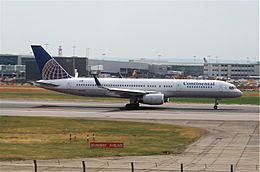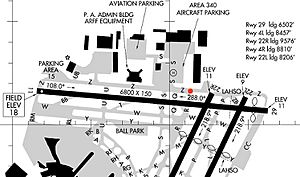Continental Airlines Flight 1883 facts for kids

N17105, the aircraft involved in the accident
|
|
| Incident summary | |
|---|---|
| Date | October 28, 2006 |
| Summary | Taxiway landing due to runway identification error |
| Place | Newark Liberty International Airport, Newark, New Jersey, United States |
| Passengers | 148 |
| Crew | 6 |
| Injuries (non-fatal) | 0 |
| Fatalities | 0 |
| Survivors | 154 |
| Aircraft type | Boeing 757-224 |
| Airline/user | Continental Airlines |
| Registration | N17105 |
| Flew from | Orlando International Airport |
| Flying to | Newark Liberty International Airport |
Continental Airlines Flight 1883 was a Boeing 757 airplane that landed by mistake on a taxiway instead of a runway. This happened at Newark Liberty International Airport on the evening of October 28, 2006. Luckily, no one was hurt and the plane was not damaged. Because this was a very close call, the National Transportation Safety Board (NTSB) investigated what happened. This event also led the Federal Aviation Administration (FAA) to make changes to how planes land and move around on the ground at Newark Airport.
Contents
About the Plane and Flight
Continental Airlines Flight 1883 was a regular flight for passengers. It flew from Orlando International Airport in Orlando, Florida, to Newark. On October 28, 2006, the flight used a Boeing 757-224 plane. This type of plane is a narrow-body, twin-engine jet airliner. Its registration number was N17105. There were 148 passengers and 6 crew members on board Flight 1883.
The co-pilot was flying the plane as it approached Newark. It was his first time landing at Newark on runway 29.
What Happened During the Flight
Flight 1883 was coming into Newark from the north. The pilots first planned to land on runway 22L. They would use a special system called an ILS to help them. As the plane flew down to about 8,000–9,000 feet (2,400–2,700 m) high, air traffic controllers told them to change plans. They were told to circle around to land on runway 29 instead.
This new plan meant flying down towards runway 22L. Then, they had to make a sharp right turn at only 900 feet (270 m) above the ground. This turn would line them up for runway 29. As the pilots flew lower and turned towards the airport, they saw four white lights. They thought these lights were on the left side of the runway. But this was a mistake. The airport's instructions said these lights should be on the right side of the runway.
Keeping the lights on their left, the pilots landed the plane on taxiway Z. This taxiway is 75 feet (23 m) wide. The landing happened at 6:31 PM EDT. The Boeing 757 jetliner has a wingspan of 124 feet (38 m). It touched down at 130 knots (240 km/h) near where taxiway Z and taxiway R meet. The plane then rolled out and stopped safely. After stopping, the plane drove to the gate. All passengers got off the plane without any problems. The FAA later confirmed that all the lights for runway 29 and taxiway Z were working fine. The runway they meant to land on, runway 29, is 150 feet (46 m) wide and 6,800 feet (2,100 m) long.
The Investigation Begins
The National Transportation Safety Board (NTSB) looked into this event. They wanted to find out why the plane landed on the wrong path.
As part of their investigation, the NTSB flew around the airport. They wanted to see how the lights looked from the air. They set the lights for runway 29 and the taxiway to the same brightness as during the incident. The NTSB noticed that the lights for taxiway Z looked a bit brighter than the lights for runway 29. However, during their tests, the different colors of the lights were clear. Taxiways use green lights in the center. Runways use white lights in the center. This color difference should help pilots tell them apart.
In their final report, the NTSB explained what they believed caused the incident. They said:
The flight crew's misidentification of the parallel taxiway as the active runway, resulting in the flight crew executing a landing on the taxiway. Contributing was the night lighting conditions.
This means the pilots thought the taxiway was the runway. The dark conditions at night also played a part.
Changes After the Incident
This unusual event made officials rethink how runways and taxiways are lit. It also led to changes in how planes approach Newark Airport. The NTSB report noted that the FAA made two types of changes. These changes were for both flying and ground procedures. They aimed to stop this kind of mistake from happening again.
For planes in the air, the FAA added two new ways to approach the airport. These new procedures, called GIMEE 19-7-1 and GRITY 19-7-1A, help pilots better find the runway. On the ground, the FAA and airport staff made the lights brighter on runways and dimmer on taxiways. This helps pilots see the difference more clearly at night.
Both pilots were not allowed to fly right after the incident. But they went through more training. After that, they were able to fly again. The plane, N17105, was later moved to United Airlines in 2010. This happened after Continental Airlines and United Airlines joined together. The plane is still being used by United Airlines as of April 2022.
See also
 In Spanish: Incidente del vuelo 1883 de Continental Airlines para niños
In Spanish: Incidente del vuelo 1883 de Continental Airlines para niños


